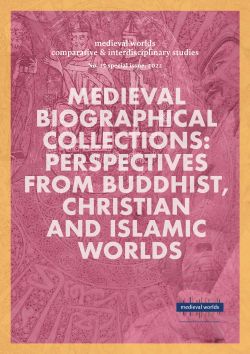Johann Heiss
S. 125 - 144
doi:
10.1553/medievalworlds_no15si_2022s125
Verlag der Österreichischen Akademie der Wissenschaften
doi:
10.1553/medievalworlds_no15si_2022s125
Abstract:
This article investigates and compares the origins, intentions and contents of two biographical collections from South Arabia. The first, al-Sulūk fī ṭabaqāt al-ʿulamā̉ wa-l-mulūk, was written by al-Janadī, who held important legal and administrative positions for the Rasūlid court during the first part of the 8th/14th century. This collection mainly emerges from an earlier Yemeni historiographical work, which described the lives of religious figures in South Arabia in the Islamic period, but sees new entries being added from the author’s own research and time. It encompasses both the lives of learned men and of political dignitaries and overall aimed to induce readers to remember and imitate the exemplary lives found in the history of al-Janadī’s beloved Yemen. The second collection, Ṭabaqāt al-khawāṣṣ ahl al-ṣidq wa-l-ikhlāṣ, was composed by al-Sharjī, a 9th/15th-century legal scholar who was motivated by his visitations of the graves of Sufis in Yemen as well as by the observation that these individuals had been left out of previous collections describing the Sufis in other parts of the Islamic world. As a result, he utilised the earlier Yemeni biographical collections, including al-Janadī’s, to put together a representation of the lives of the Sufis of South Arabia. Towards the end of this article there is a detailed comparison made between the alternative biographies of the same man found in the two collections, thus illustrating the differences apparent in the respective foci of these two historians.
Rasūlid, Sufi, historiography, biography, Yemen, Islamic world
Published Online:
2022/06/08 10:16:42
Object Identifier:
0xc1aa5576 0x003d78a3
Rights:https://creativecommons.org/licenses/by-nd/4.0/
medieval worlds provides a forum for comparative, interdisciplinary and transcultural studies of the Middle Ages. Its aim is to overcome disciplinary boundaries, regional limits and national research traditions in Medieval Studies, to open up new spaces for discussion, and to help developing global perspectives. We focus on the period from c. 400 to 1500 CE but do not stick to rigid periodization.
medieval worlds is open to submissions of broadly comparative studies and matters of global interest, whether in single articles, companion papers, smaller clusters, or special issues on a subject of global/comparative history. We particularly invite studies of wide-ranging connectivity or comparison between different world regions.
Apart from research articles, medieval worlds publishes ongoing debates and project and conference reports on comparative medieval research.
Medieval Biographical Collections: Perspectives from Buddhist, Christian and Islamic Worlds
Guest editors: Daniel Mahoney, Diarmuid Ó Riain and Giorgia Vocino
Editorial
Walter Pohl and Ingrid Hartl
Introduction
Medieval Biographical Collections in Comparison
Daniel Mahoney and Giorgia Vocino
Introductory Comparative Chapters
Compilation Strategies
Daniel Mahoney and Diarmuid Ó Riain
Writing Strategies
Reinier Langelaar, Giorgia Vocino and Veronika Wieser
Audience and Reception
Rutger Kramer and Graeme Ward
Case Studies
Many Lives, One Story: The Gesta Sanctorum Rotonensium and the Making of Redon
Rutger Kramer
Biography and Hierarchy: The Tibetan Ruling House of Phag-mo-gru and the Singular Volume of the Rlangs (Rlangs-kyi-po-ti-bse-ru)
Reinier Langelaar
Reading Jerome’s De viris illustribus in the Post-Roman World: Cataloguing Community in Gennadius of Marseille and Frechulf of Lisieux
Graeme Ward and Veronika Wieser
Shaping Community through Biographical Collections from South Arabia: A Comparison of Two Ṭabaqāt-works
Johann Heiss
Compiling the Deeds of Salzburg Saints: The 12th-Century De episcopis Salisburgensibus and the Monastery of Admont
Diarmuid Ó Riain
Obituaries in Service of the Rasūlid Sultanate in Yemen at the Turn of the 9th/15th Century
Daniel Mahoney
Creating a Sense of Glorious Destiny. Mastery of Speech in the Libellus de Situ Civitatis Mediolani (Late 10th-Early 11th Centuries)
Giorgia Vocino
Conclusion
Communities and Contexts: Concluding Thoughts on Medieval Biographical Collections
Diarmuid Ó Riain




 Home
Home Print
Print
 References
References
 Share
Share
